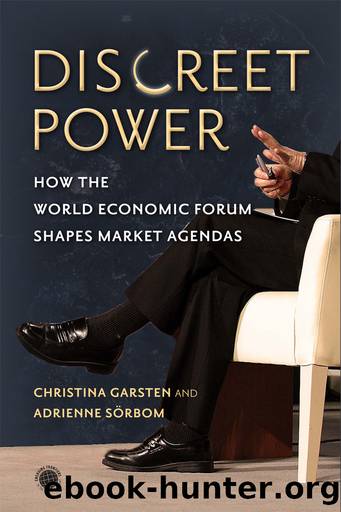Discreet Power by Christina Garsten

Author:Christina Garsten [Garsten, Christina]
Language: eng
Format: epub
Publisher: Stanford University Press
Published: 2018-09-15T00:00:00+00:00
PHOTO 4.1. Our badges from WEF Summit on the Global Agenda, Dubai 2012. Source: Garsten and Sörbom.
For the status-conscious attendees, the color coding of the badges provides quick and useful information about the badge ownerâs relationship to the Forum. It signals the weight of that personâs invitation, the degree of access provided, and the role he or she is expected to perform at the event. A white hologram badge may make security personnel, journalists, and waiters more attentive, gracious, and service minded. A purple badge usually goes without notice. In sociologist Erving Goffmanâs dramaturgical terminology, badges signal who is to appear front stage and who is delegated to a backstage role.18 Technicians, drivers, and other service staff may, to use Goffmanâs term, be considered ânonpersonsâ and have discrepant roles. They are the ones who appear both front stage and backstage but are not considered part of the performance. The audience and the performers do not acknowledge their roles, and they are viewed in some aspect as outsiders. The fact that most of the time, we had no badge signaled that we were not even in the play. The one time we were granted badges, during the Global Agenda Council Meeting in Dubai, they were white badges with a blue line and the title âMedia Leader,â which identified us as official invitees.
Sporting a badge is thus quintessential for displaying status and distinction and may serve as a signal of membership in one of the WEF communities. As sociologist William Goode shows, status distinctions rely on the reputation created by myriad rankings, evaluations, and feedback in daily life, by groups and organizations, which will affect those under scrutiny.19 In order to create personal esteem, individuals and organizations may draw on their membership or belonging to groups and organizationsâeffective for both policymakers and business leaders.20 Again, the status order constructed and formatted by the Forum works both ways. As much as the individual participant may develop her or his esteem, the Forum on its behalf draws on status orders for both delivering its messages and securing its position as a broker of ideas of consequence. By closing the gates to people who are not recognized as part of the group of world leaders, it confers social honor and status on those who are invited. The status hierarchy of badges reinforces the seductive quality of the organization and generates attraction and desire in potential participants. The badge is an important âobject of desire,â in psychoanalyst Jacques Lacanâs viewâan almost unattainable objet petitâand a stamp of approval by the gatekeepers for those who have it.21 Indeed, it works to attract leaders from all corners of the world to meet other leaders who have also qualified. For one to be among the selected few, knowing that, like all the other participants, one has been carefully scrutinized and judged to pass is to rest assured that the ties nurtured within the WEF may work to influence the future agenda in the direction one desires.
At the other end
Download
This site does not store any files on its server. We only index and link to content provided by other sites. Please contact the content providers to delete copyright contents if any and email us, we'll remove relevant links or contents immediately.
International Integration of the Brazilian Economy by Elias C. Grivoyannis(57389)
The Radium Girls by Kate Moore(10915)
Turbulence by E. J. Noyes(7057)
Nudge - Improving Decisions about Health, Wealth, and Happiness by Thaler Sunstein(6642)
The Black Swan by Nassim Nicholas Taleb(6203)
Pioneering Portfolio Management by David F. Swensen(5616)
Rich Dad Poor Dad by Robert T. Kiyosaki(5162)
Zero to One by Peter Thiel(4834)
Man-made Catastrophes and Risk Information Concealment by Dmitry Chernov & Didier Sornette(4748)
Secrecy World by Jake Bernstein(3788)
Millionaire: The Philanderer, Gambler, and Duelist Who Invented Modern Finance by Janet Gleeson(3576)
Skin in the Game by Nassim Nicholas Taleb(3477)
The Age of Surveillance Capitalism by Shoshana Zuboff(3432)
The Money Culture by Michael Lewis(3291)
Skin in the Game: Hidden Asymmetries in Daily Life by Nassim Nicholas Taleb(3272)
Bullshit Jobs by David Graeber(3190)
The Dhandho Investor by Mohnish Pabrai(3176)
The Wisdom of Finance by Mihir Desai(3086)
Blockchain Basics by Daniel Drescher(2896)
